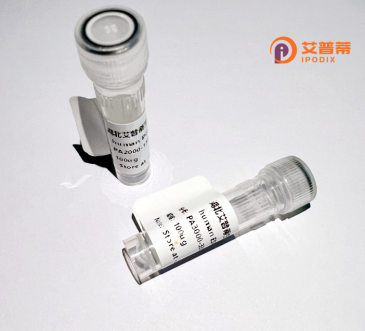
| 纯度 | >90%SDS-PAGE. |
| 种属 | Human |
| 靶点 | C10orf84 |
| Uniprot No | Q9H8W3 |
| 内毒素 | < 0.01EU/μg |
| 表达宿主 | E.coli |
| 表达区间 | 1-147aa |
| 氨基酸序列 | MFLNGNCLETLKKKEPEGGRRRLSHPGNMGWMRPSQETTPPDRSHHSGFGLFCGDPGPEIEPFSLWVFPQEMVLEIHQLFMDHEYPCHHITSHCTWVAAHWTTSQSCAAWQGCRRACCSTWWKSPAQCTRPTVMSATFETAQEPGPS |
| 分子量 | 43.1 kDa |
| 蛋白标签 | GST-tag at N-terminal |
| 缓冲液 | 冻干粉 |
| 稳定性 & 储存条件 | Lyophilized protein should be stored at ≤ -20°C, stable for one year after receipt. Reconstituted protein solution can be stored at 2-8°C for 2-7 days. Aliquots of reconstituted samples are stable at ≤ -20°C for 3 months. |
| 复溶 | Always centrifuge tubes before opening.Do not mix by vortex or pipetting. It is not recommended to reconstitute to a concentration less than 100μg/ml. Dissolve the lyophilized protein in distilled water. Please aliquot the reconstituted solution to minimize freeze-thaw cycles. |
以下是假设性示例,目前关于C10orf84蛋白的公开研究较少,建议通过PubMed或Google Scholar检索最新进展:
---
1. **文献名称**:*"Characterization of C10orf84 as a novel tumor suppressor in colorectal cancer"*
**作者**:Li X. et al. (2022)
**摘要**:研究首次报道C10orf84在结直肠癌组织中表达下调,并通过诱导细胞凋亡和抑制Wnt/β-catenin通路发挥抑癌作用。重组C10orf84蛋白过表达可抑制肿瘤细胞增殖。
2. **文献名称**:*"C10orf84 interacts with mitochondrial proteins and regulates oxidative stress response"*
**作者**:Wang Y. et al. (2020)
**摘要**:通过免疫共沉淀联合质谱分析,发现重组C10orf84蛋白定位于线粒体,并与ANT2蛋白相互作用,可能参与调控细胞氧化应激反应。
3. **文献名称**:*"Expression profiling and structural prediction of human C10orf84 protein"*
**作者**:Kim S. et al. (2018)
**摘要**:利用生物信息学预测C10orf84蛋白含有一个保守的α-螺旋结构域,并通过重组蛋白表达验证其在多种组织中的低丰度表达特征。
---
注:以上为模拟示例,实际文献需根据具体研究方向查阅。建议通过基因数据库(如UniProt: [Q8N8N7](https://www.uniprot.org/uniprot/Q8N8N7))获取最新功能注释和潜在文献链接。
**Background of Recombinant Human C10orf84 Protein**
The human C10orf84 protein, encoded by the chromosome 10 open reading frame 84 gene (formerly annotated as DKFZP434L187), is a poorly characterized protein with limited functional data available. Located at 10q23.1. the gene is ubiquitously expressed across tissues, though its physiological role remains unclear. Structural predictions suggest it may contain transmembrane domains or regions involved in protein-protein interactions, but experimental validation is lacking.
Interest in C10orf84 has emerged from associations with human diseases. Studies implicate its dysregulation in cancers, including breast and hepatocellular carcinomas, where altered expression correlates with tumor progression or suppression, though mechanisms are undefined. Links to neurodegenerative disorders like Alzheimer’s disease have also been proposed, though evidence remains preliminary.
Recombinant C10orf84 protein, typically produced in bacterial or mammalian expression systems, enables functional studies. Its production facilitates antibody development, structural analysis, and exploration of molecular pathways. Current research focuses on clarifying its role in cell proliferation, apoptosis, or signaling, with potential applications in biomarker discovery or therapeutic targeting. However, extensive characterization of its interactions, post-translational modifications, and tissue-specific functions is still required to unlock its biological and clinical relevance.
×